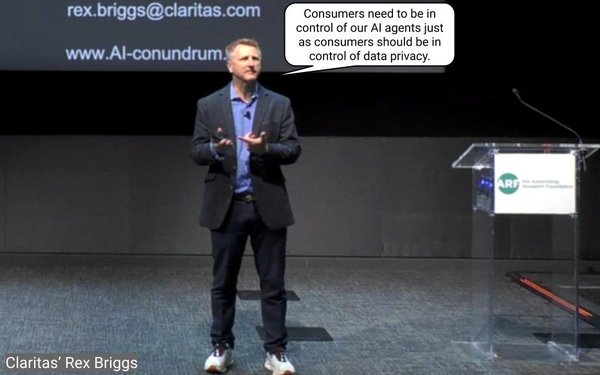Commentary
ARF Day One: Research And Measurement Becoming Ever More Complex
- by Tony Jarvis , Op-Ed Contributor, March 21, 2024

The opening day of the Advertising Research Foundation’s (ARF) Audience X Science Conference in New York City Wednesday, as always, offered intriguing insights on leading edge topics including AI and attention metrics for media and brands.
In his opening remarks, President and CEO Scott McDonald noted the continuation of media fragmentation, growth of new media options (notably retail media networks), privacy implications, and use of AI, further challenge research and measurement for content providers, as well as ad buyers and sellers.
A variety of presentations from industry experts attempted to address these challenges and the opportunities new techniques and technologies to help resolve them.
The theme of the opening keynote by Claritas Chief AI Officer Rex Briggs was “AI Agents To Represent Us, Not Replace Us.” A conundrum indeed.
advertisement
advertisement
Briggs focused on the use of AI to help us more rapidly and cost effectively understand and create identities – or “personas” – similar to those that Claritas has been providing via its PRIZM Premier Life Stage groups for many years.
What was gratifying were his cautions, based on an array of sophisticated experiments, regarding the dangers and risks of using massive Big Data sets and AI’s power to provide amazing results that were far from perfect.
Briggs’ statement that “consumers need to be in control of our AI agents just as consumers should be in control of data privacy,” was surely a North Star for our industry.
Perhaps there is a parallel for AI to social media, which is posing a threat to democracy? Does AI’s value outweigh its use for destructive purposes?
From a research survey perspective, based on real people, can an AI aggregation be truly representative of an extraordinarily complex universe? Will it kill media research? Will it replace researchers? Or will it, as Briggs suggested, make survey research and researchers even more valuable?
The “attention economy” has firmly established itself in the media measurement and ad effectiveness arena. However, its use and interpretation has raised as many questions as it has provided answers.
Amplified Intelligence CEO Karen Nelson-Field is a world leader in providing guidance on use, measurement and interpretation of attention metrics. She has determined that, as presented, “The value of attention is nuanced by the size of the brand.” In other words, big and small brands need different types of attention to achieve outcomes.
Nelson-Field found differences between “passive attention” (likelihood-to-see or hear) and “active attention” (eyes/ears-on or contacts), with the latter being more “vital to outcomes.”
However, understanding attention becomes even more complex as each attention level works differently for different brands in brand choice outcomes and one second of attention works differently for each level. “Active attention is particularly needed by smaller brands,” she noted.
For those embracing so called “viewable impression” metrics that are solely content rendered counts based on device/surface measures, she warned, “Time-in-view fundamentally fails” as it does not account for key variables including: attention, how long it is sustained, possible decay rates, and the reach of the brand target group, which are all required to drive outcomes.
There are also multiple media considerations that impact the range of attention interactions including device used, media platform/media type, ad format, context, demo, and of course, the creative power of the message.
Some of Nelson-Field’s conclusions:
Non-human measurements (surrogates) for attention are not reliable.
Outcomes cannot predict attention due to nuances and the “creative power factor.”
Attention strategies should be tailored to campaign requirements not simply to high/low attention quality, or more or less time.
Media Science CEO Duane Varan added to Nelson-Field’s presentation, via his insights on, “The Impact of Co-Viewing on Attention to Video Advertising.”
Co-Viewing, he said, has a key effect on attention reduction, but more so on memory as it potentially reduces the retrieval of memories depending on programming – not platform – as the key variable.
Like other presenters, Varan emphasized that program content and context are important contributors to driving ad effects, although many presenters reminded attendees that advertising creative content is king when it comes to driving outcomes.



